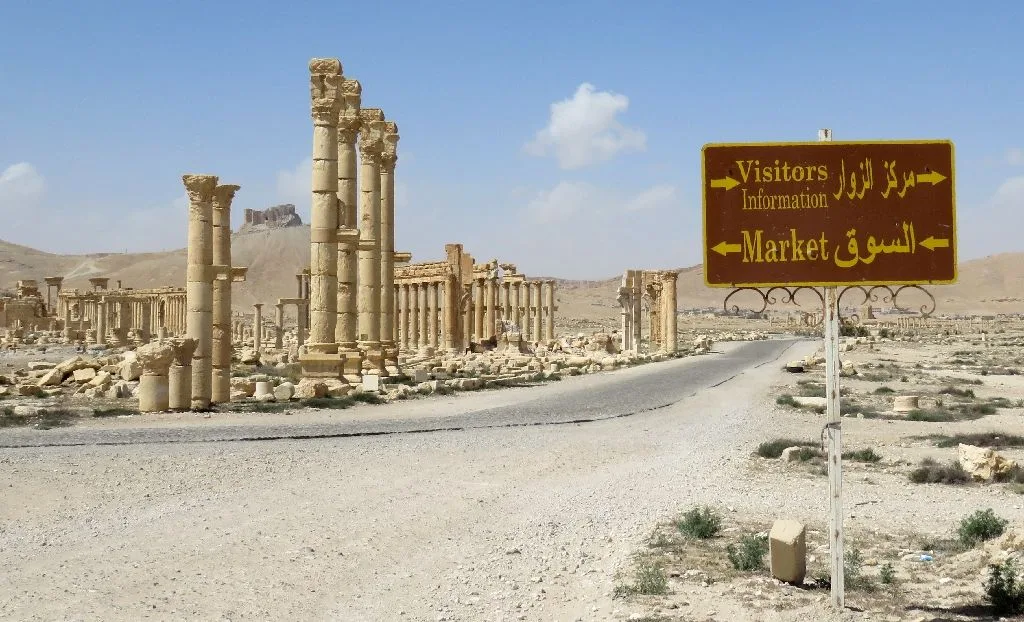
the UNESCO world heritage site from the Islamic State group
[Credit: AFP/Maher AL Mounes]
Experts say they need time to assess the full extent of damage in Palmyra, a UNESCO world heritage site boasting 2,000-year-old Roman-era colonnades and other ruins, which once attracted tens of thousands of tourists every year. Syrian troops drove IS out on Sunday, some 10 months after the militants seized the town.
The world knew through satellite images and IS videos that the militants destroyed the Temple of Bel, which dated back to A.D. 32, the Temple of Baalshamin, which was several stories high and fronted by six towering columns, and the Arch of Triumph, which was built under the Roman emperor Septimius Severus between A.D. 193 and A.D. 211.
But no one knew the extent of the damage inside the museum until a Syrian TV reporter entered on Sunday and found the floor littered with shattered statues. A sculpture of the Greek goddess Athena was decapitated, and the museum's basement appeared to have been dynamited or hit with a shell.
Some of the damage may have been caused by shelling, which would have knocked the statues from their stands. In the Syrian TV footage from inside the museum, a hole can be seen in the ceiling, most likely from an artillery shell.
Unlike in the Iraqi city of Mosul, where IS militants filmed themselves with sledgehammers proudly destroying ancient artifacts, no militant video was released from Palmyra's museum.
Before Palmyra fell to IS, authorities were able to relocate more than 400 statues and hundreds of artifacts to safe areas, but larger statues couldn't be moved, according to the head of antiquities and museums, Maamoun Abdul-Karim. He told the AP that about 20 statues were defaced and others had their heads chopped off. State media had earlier reported that a 2nd century lion statue, previously thought to have been destroyed by IS, was damaged but could be restored.

before it was blown up by ISIL, and what was found after Syrian troops
recaptured the ancient site on March 27, 2016 [Credit: Joseph Eid
and Maher Al Mounes/AFP]
Abdul-Karim said he was relieved that many of the statues had only been disfigured and not demolished. "It's like having a person whose face was burnt. He is not as good looking as he used to be but he is still alive," he said.
He said officials have a list of all the statues that were left behind in Palmyra when IS captured the town, which will help in documenting the damage.
Amr al-Azm, a former Syrian antiquities official who is now a professor at Shawnee State University in Ohio, is less sanguine.

jihadists in October 2015 in the ancient Syrian city of Palmyra
[Credit: AFP/Maher AL Mounes]
"The level of destruction and vandalism inside the museum is much more significant than we had realized," he said. Smashing up statues' faces "means that there is nothing left," he added.
The Sunni extremist group, which has imposed a violent interpretation of Islamic law across the territory it controls in Syria and Iraq, claims ancient relics promote idolatry. But it is also believed to have profited from looted antiquities.
That may explain why the militants killed the archaeological site's 81-year-old director, Khaled al-Asaad, who was beheaded last August after he reportedly refused to say where authorities had hidden some of the town's treasures.

troops recaptured the UNESCO world heritage site from the Islamic State group
[Credit: AFP/Maher AL Mounes]
Al-Asaad, who was among scores of people killed by the extremists after they seized the town, had devoted his life to studying Palmyra, and could have played an invaluable role in documenting the damage and restoring its antiquities.
It will take time to assess the extent of the losses and determine if IS carried out excavations or smuggled artifacts out. But the initial findings suggest at least some of the damage is permanent.
Martin Makinson, an archaeologist who lived and worked in Syria until 2011, said the Temple of Baalshamin "was pretty much obliterated," along with three ancient tombs. He said the inner sanctum of the Temple of Bel was also destroyed.

as a venue for public executions [Credit: AFP/Maher AL Mounes]
"Unfortunately the damage that ISIS has caused to the site is pretty irreparable and it would be a sort of reconstruction in some sectors," Makinson said, using another acronym for IS.
Al-Azm said highly specialized teams will have to go into the hardest-hit areas "to start to document and record each and every stone to try and see what can be restored." He said IS had specifically targeted the most important monuments.
Asked how bad the damage is, Al-Azm replied: "On the scale of one to 10 it is 10. The only other thing that causes that much damage to a city is probably some earthquake that struck at some time. It was pretty devastating."
Authors: Albert Aji and Bassem Mroue | Source: The Associated Press [March 28, 2016]